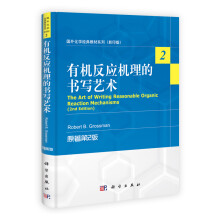国外化学经典教材系列(影印版):有机反应机理的书写艺术(原著第2版)

目 录内容简介
ContentsPreface to the Student vPreface to the Instructor ix1 The Basics 11.1 Structure and Stability of Organic Compounds 11.1.1 Conventions of Drawing Structures; Grossman's Rule 11.1.2 Lewis Structures; Resonance Structures 31.1.3 Molecular Shape; Hybridization 91.2 BrOnsted Acidity and Basicity 161.3 Kinetics and Thermodynamics 201.4 Getting Started in Drawing a Mechanism 221.5 Classes of Overall Transformations 251.6 Classes ofMechanisms 261.6.1 Polar Mechanisms 271.6.2 Free-Radical Mechanisms 381.6.3 Pericyclic Mechanisms 411.6.4 Transition-Metal-Catalyzed and Mediated -Mechanisms 422 Polar Reactions under Basic Conditions502.1 Substitution and Elimination at C(sp3)-Bonds, Part I 502.1.1 Substitution by the SN2 Mechanism 512.1.2 β-Elimination by the E2 and Elcb Mechanisms 532.1.3 Predicting Substitution vs Elimination 562.2 Addition of Nucleophiles to Electrophilic 7r Bonds 582.2.1 Addition to Carbonyl Compounds 582.2.2 Conjugate Addition; The Michael Reaction 672.3 Substitution at C(sp2)-X u Bonds 692.3.1 Substitution at Carbonyl C 692.3.2 Substitution at Alkenyl and Aryl C 742.3.3 Metallnsertion; Halogen-Metal Exchange 782.4 Substitution and Elimination at C(sp3)-X cr Bonds, Part II 802.4.1 Substitution by the SRNl Mechanism 802.4.2 Substitution by the Elimination-Addition Mechanism 812.4.3 Substitution by the One-Electron Transfer Mechanism 822.4.4 Metallnsertion; Halogen-Metal Exchange 832.4.5 α-Elimination; Generation and Reactions of Carbenes 842.5 Base-Promoted Rearrangements 872.5.1 Migration from C to C 882.5.2 Migration from C to O or N 902.5.3 Migration from B to C or O 912.6 Two Multistep Reactions 922.6.1 The Swern Oxidation 922.6.2 The Mitsunobu Reaction 943 Polar Reactions Under Acidic Conditions1053.1.1 Carbocation Stability 1063.1.2 Carbocation Generation; The Role of Protonation 1093.1.3 Typical Reactions ofCarbocations; Rearrangements 1123.2 Substitution and p-Elnuination Reactions at C(sp3)-X 1173.2.1 Substitution by the SNl and SN2 Mechanisms 1173.2.2 β-Elimination by the El Mechanism 1203.2.3 Predicting Substitution vs Elimination 1223.3 Electrophilic Addition to Nucleophilic C=C 7r Bonds 1223.4 Substitution at Nucleophilic C=C 7r Bonds 1253.4.1 Electrophilic Aromatic Substitution 1253.4.2 Aromatic Substitution of Anilines via Diazonium Salts 1293.4.3 Electrophilic Aliphatic Substitution 1313.5 Nucleophilic Addition to and Substitution at Electrophilic π Boods 1323.5.1 Heteroatom Nucleophiles 1323.5.2 Carbon Nucleophiles 1364 Pericyclic Reactions 1484.1.1 Classes ofPericyclic Reactions 1484.2 Electrocyclic Reactions 1564.2.1 Typical Reactions 1564.2.2 Stereospecificity 1634.2.3 Stereoselectivity 1684.3 Cycloadditions 1704.3.1 Typical Reactions 1704.3.2 Regioselectivity 1834.3.3 Stereospecificity 1844.3.4 Stereoselectivity 1914.4 Sigmatropic Rearrangements 1954.4.1 TypicalReactions 1954.4.2 Stereospecificity 2014.4.3 Stereoselectivity 2064.5 Ene Reactions 2105 Free-Radical Reactions 2245.1.1 Stability 2245.1.2 Generation from Closed-Shell Species 2275.1.3 Typical Reactions 2325.1.4 Chain vs Nonchain Mechanisms 2385.2 Chain Free-Radical Reactions 2395.2.1 Substitution Reactions 2395.2.2 Addition and Fragmentation Reactions 2445.3 Nonchain Free-Radical Reactions 2525.3.1 Photochemical Reactions 2525.3.2 Reductions and Oxidations with Metals 2545.3.3 Cycloaromatizations 2615.4 Miscellaneous Radical Reactions 2615.4.1 1,2-Anionic Rearrangements; Lone-Pairlnversion 2615.4.2 Triplet Carbenes and Nitrenes 2626 Transition-Metal-Mediated and -Catalyzed Reactions 2706.1 Introduction to the Chemistry of Transition Metals 2706.1.1 Conventions of Drawing Structures 2706.1.2 Counting Electrons 2716.1.3 Typical Reactions 2766.1.4 Stoichiometric vs Catalytic Mechanisms 2826.2 Addition Reactions 2836.2.1 Late-Metal-Catalyzed Hydrogenation and Hydrometallation (Pd, Pt, Rh) 2836.2.2 Hydroformylation (Co, Rh) 2866.2.3 Hydrozirconation (Zr) 2876.2.4 Alkene Polymerization (Ti, Zr, Sc, and others) 2886.2.5 Cyclopropanation, Epoxidation, and Aziridination of Alkenes (Cu, Rh, Mn, Ti) 2906.2.6 Dihydroxylation and Aminohydroxylation of Alkenes(Os) 2926.2.7 Nucleophilic Addition to Alkenes and Alkynes (Hg,Pd) 2946.2.8 Conjugate Addition Reactions (Cu) 2976.2.9 Reductive Coupling Reactions (Ti, Zr) 2976.2.10 Pauson-Khand Reaction (Co) 3016.2.12 Metal-Catalyzed Cycloaddition and Cyclotrimerization (Co, Ni, Rh) 3066.3 Substitution Reactions 3096.3.1 Hydrogenolysis (Pd) 3096.3.2 Carbonylation of Alkyl Halides (Pd, Rh) 3116.3.4 Coupling Reactions Between Nucleophiles and C(sp2)-X:
目 录内容简介
每一个满怀抱负的有机化学家都尝试写出合理的有机反应机理,然而市面上的有关机理正确书写的书籍却寥寥无几。《有机反应机理的书写艺术》将帮助学生和科研人员提高这一重要技能。《有机反应机理的书写艺术》的突出特点体现在:正确的书写形式,“常见错误提示”,配以大量的难度适宜的问题。其另一个特色是包含过渡金属参与或催化的反应章节。相对新的课题,例如,烯烃复分解反应、芳香环化反应等在本《有机反应机理的书写艺术》均有所涉及。 全新修订的第2版精彩呈现:更新的反应机理,芳香性的讨论,酸性,立体化学的拓展,重新组织了自由基反应和金属参与或催化的反应等内容,增加了新的问题。
比价列表
1人想要1人拥有
公众号、微信群
 缺书网
缺书网微信公众号
 扫码进群
扫码进群实时获取购书优惠






